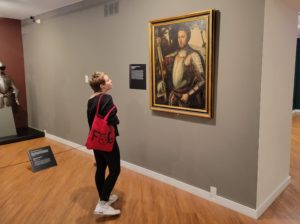
POV provides AMA friends and fans the opportunity to share their knowledge and point of views about art. This POV was submitted by guest contributor Nathan Boschult from Texas Real Estate Source.
![]()
Taking time to appreciate art can benefit your overall well-being in many ways. Looking at art is a great way to spark your creativity or connect with history. Beyond that, art’s visual, emotional, and cognitive stimulation can benefit the brain.
Keep reading to discover how art’s effect on the brain reduces anxiety, bolsters neuroplasticity, improves focus, and more.
![]()
Looking at Art Reduces Stress
Do you feel less stress after spending time at the Arlington Museum of Art? You’re not just imagining it. Scientific evidence suggests that viewing art can reduce stress levels for various reasons.

For starters, art makes us happy! When we see images we enjoy, whether they’re photorealistic or abstract, our brain releases dopamine and endorphins that help us feel alert but at ease. Art can also trigger feelings of appreciation or nostalgia, further calming the mind.
Additionally, the colors and shapes we experience in visual art have been known to stimulate creativity and a sense of well-being. Even the rush of adrenaline we experience when seeing something striking, dramatic, or harrowing can lead to an elevated mood.
How does this happen? Your eyes are actually part of your brain function. They provide tons of information to your central nervous system.
It’s not just about WHAT you see, but also HOW you see it. The way we see things sends signals to our brain that, in turn, tell the rest of our brain and body to feel relaxed or alert.
When you’re stressed, for instance, your vision narrows to heighten focus. Unfortunately, many of us maintain this narrow vision all day long. Have you ever spent all day working at the computer, then go home and watch videos or scroll social media on your phone? Doing so keeps your eyes in a narrow state of focus, which sends mixed signals to your brain and leaves you feeling stressed when you don’t want or even need to be.
Instead, when you’re at the museum, you can choose to take a BIG STEP BACK. Imagine standing in front of a large painting and stepping back until you capture the entire scene in your field of vision. By engaging in panoramic vision, you’re very likely to feel a significant drop in stress.
![]()
Looking at Art Helps Us Recognize the Beauty Around Us
Aesthetic appreciation is a skill that can be improved over time. There are no right or wrong answers when it comes to art. Part of enjoying a museum experience is discerning your own taste and learning to articulate what you like about any particular piece. Viewing and analyzing aesthetics can improve emotional well-being, according to a study done at the Roma Tre University in Italy. This practice may start in the museum but can follow you wherever you go.
 Aesthetics can be found all around you. Imagine hiking through the Texas Hill Country and noticing the textures of the dirt path or the unique hues found in a chunk of pink granite. Developing a sense of appreciation for these small details through art helps you enjoy them more in the real world.
Aesthetics can be found all around you. Imagine hiking through the Texas Hill Country and noticing the textures of the dirt path or the unique hues found in a chunk of pink granite. Developing a sense of appreciation for these small details through art helps you enjoy them more in the real world.
Learning to appreciate art also increases your neuroplasticity. Neuroplasticity is the brain’s ability to form new neurons and establish new habits and perspectives. It’s a process that takes place in every stage of life. Increasing neuroplasticity through art can help us begin thinking and acting in a way that helps us see the value of art in many cities through public works, historic sites, and architecture.
Take the city of Lubbock, TX for example. Recent preservation efforts have helped protect buildings in dozens of architectural styles, ranging from Victorian to Neo-Classical Revival. This commitment to the community’s character and personality couldn’t have been accomplished without an appreciation for art and aesthetics. Next time you’re exploring a new city, take a moment to acknowledge art everywhere you look.
![]()
Looking at Art Can Increase Your Focus
Viewing art has also been shown to improve focus and productivity. When looking at art, many people report experiencing a “flow state.” This is a highly focused mental state where you become utterly engrossed in the activity at hand. It’s often associated with creativity or problem-solving.
 Most people love the feeling of getting lost in an activity. Whether it’s going for a long run or reading a captivating novel, people seek a flow state in many ways. The more time we spend in flow, the more access we have to it later on. This highly focused state can be part of our everyday life by diversifying our flow experiences through art, fulfilling work, and socialization.
Most people love the feeling of getting lost in an activity. Whether it’s going for a long run or reading a captivating novel, people seek a flow state in many ways. The more time we spend in flow, the more access we have to it later on. This highly focused state can be part of our everyday life by diversifying our flow experiences through art, fulfilling work, and socialization.
![]()
Looking at Art Empowers Your Empathy
It’s hard to describe why humans are so drawn to art and creative expression. One of the many benefits of engaging with creativity is that it allows us to enter another person’s point of view and experience their emotions. At the same time, we’re not implicated by any other stresses that might be afflicting the artist, giving us a rare opportunity to safely process feelings and practice empathy.
Viewing art through an empathetic lens is likely to pay off later on. Research shows that regularly exercising your capacity for empathy makes it easier for our brains to cope with emotional experiences later on.
![]()
Get a Brain Boost From Art!
Art significantly impacts our brains and lives, whether we realize it or not. From reducing stress and increasing focus to empowering empathy, viewing art is beneficial in many ways. The next time you’re feeling overwhelmed, take a walk through an art museum like the Arlington Museum of Art, or just take in the beauty around you. Your brain will thank you.
